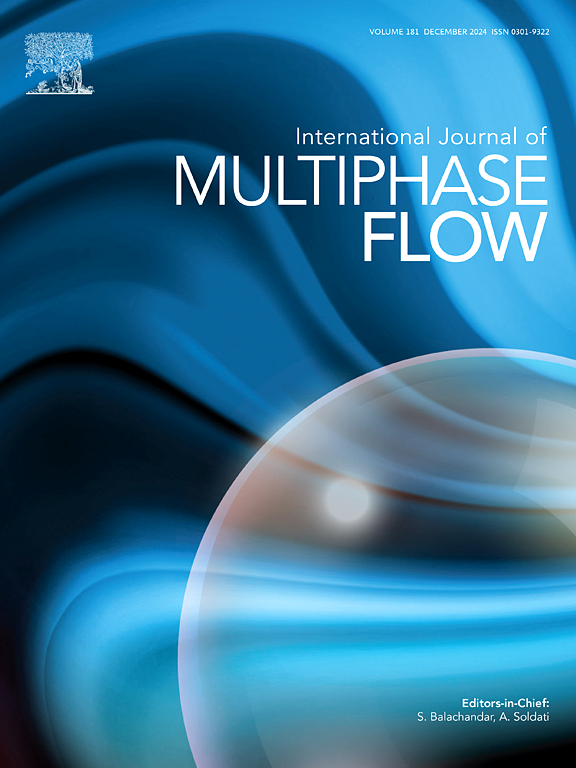低粘度比分层液-液流动中的高原-瑞利不稳定性
IF 3.6
2区 工程技术
Q1 MECHANICS
International Journal of Multiphase Flow
Pub Date : 2025-04-21
DOI:10.1016/j.ijmultiphaseflow.2025.105253
引用次数: 0
摘要
层状液-液流动由于其复杂的界面相互作用及其在特定操作条件下的水动力稳定性,至今仍是一个开放的研究课题。文献中包含了不同的理论来解释分层流的转变。最近的一种理论认为,界面的截面曲率与毛细不稳定性有关,这种影响在高水体积分数时更强。在这种情况下,界面张力有助于在流动截面处形成凹界面。然而,就作者而言,没有实验研究量化与界面截面曲率相关的破坏稳定的界面张力项的大小,这可能导致分层流动过渡到塞流。我们在一个新的实验装置中使用平面激光诱导荧光(PLIF)和阴影尺寸技术测量了低Eötvös数水平分层油水管道流的这种效应。采用低粘度比1.44的矿物油和自来水。采用自制的油水界面扫描识别算法,确定了稳定流动和不稳定流动条件下界面波在流动纵向、直径垂直和横截面上的几何和运动特性。首次测量了分层管流的界面截面曲率。提出了一种新的界面截面曲率与平均水高的关系式,平均水高与界面张力有关,而界面张力对过渡起主导作用。基于一维双流体模型的线性稳定性分析表明,在某些特定的流动条件下,毛细不稳定性足以促进分层流向塞流的转变。界面张力是不稳定的主要来源,但黏度和惯性力对分层流动的过渡也有显著影响。此外,研究结果表明,界面张力的稳定作用是本研究分层流稳定的主要原因。应用一般稳定性判据预测了平滑分层到波浪分层的中性稳定性过渡边界。本文章由计算机程序翻译,如有差异,请以英文原文为准。

Plateau–Rayleigh instability in low-viscosity ratio stratified liquid–liquid flow
Stratified liquid–liquid flow is still an open research subject due to the complex interfacial interactions and its hydrodynamic stability in specific operational conditions. The literature contains different theories explaining the stratified flow transition. A recent theory suggests that the interface’s cross-section curvature is related to capillary instability, which effect is stronger at high water volumetric fractions. At such conditions, interfacial tension contributes to forming a concave interface at the flow’s cross-section. Nevertheless, as far as the authors are concerned, no experimental study has quantified the magnitude of the destabilizing interfacial-tension term related to the interface’s cross-section curvature, which can lead stratified flow to transition to plug flow. We measure such an effect in a horizontal stratified oil–water pipe flow with low Eötvös number using Planar Laser-Induced Fluorescence (PLIF) and shadow sizing techniques in a novel experimental facility. Mineral oil and tap water with a low-viscosity ratio of 1.44 were used. Geometrical and kinematic properties of the interfacial wave at the flow’s longitudinal diametrical vertical and cross-section planes for stable and unstable flow conditions were determined by a homemade scanning algorithm that identifies the oil–water interface. The interface’s cross-section curvature of stratified pipe flow was measured for the first time. A novel expression was proposed to correlate the interface’s cross-section curvature with the mean water height, which is associated with the interfacial tension force that has a dominant effect on transition. A linear stability analysis based on the 1-D two-fluid model was carried out and suggested that capillary instability can be strong enough to promote the transition from stratified to plug flow at some specific flow conditions. The interfacial tension force is the main source of instability, but viscosity and inertial forces also significantly affect the transition of stratified flow. Furthermore, the results indicated that the stabilizing effect of interfacial tension is the force responsible for the stability of the stratified flow studied in this work. The neutral stability transition boundary from stratified smooth to wavy stratified was predicted by applying a general stability criterion.
求助全文
通过发布文献求助,成功后即可免费获取论文全文。
去求助
来源期刊
CiteScore
7.30
自引率
10.50%
发文量
244
审稿时长
4 months
期刊介绍:
The International Journal of Multiphase Flow publishes analytical, numerical and experimental articles of lasting interest. The scope of the journal includes all aspects of mass, momentum and energy exchange phenomena among different phases such as occur in disperse flows, gas–liquid and liquid–liquid flows, flows in porous media, boiling, granular flows and others.
The journal publishes full papers, brief communications and conference announcements.

 求助内容:
求助内容: 应助结果提醒方式:
应助结果提醒方式:


